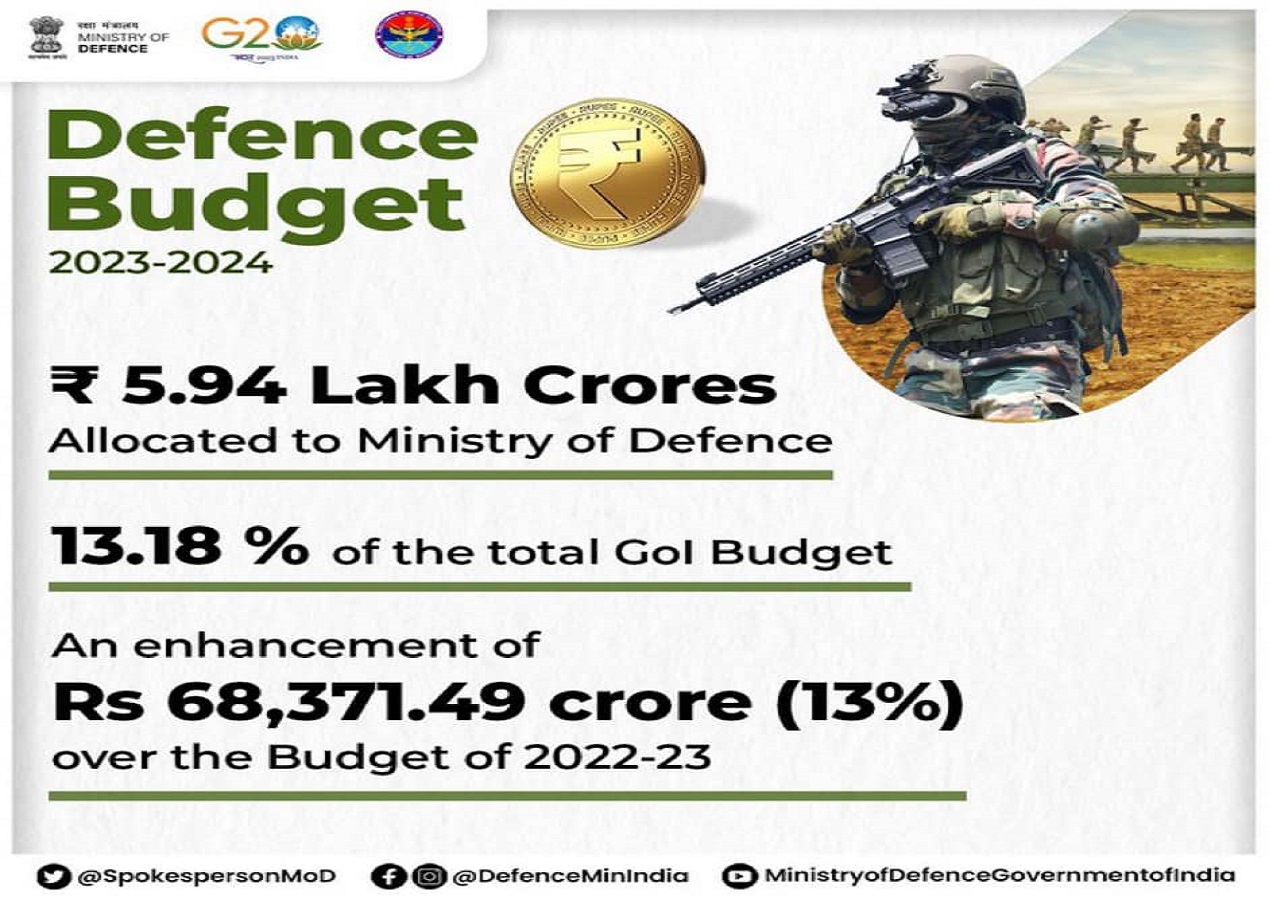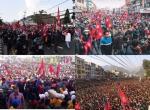Presenting the Union Budget 2023-24 before the Parliament on February 01, the Finance Minister, Nirmala Sitharaman, allocated Rs 5.94 lakh crore—about US$72 billion—to the Ministry of Defence (MoD). While allocating the new budget for the MoD, the FM also revealed an 11 per cent mid-year jump in the previous defence allocation to Rs 5.85 lakh crore.
Representing an increase of 13 per cent, the MoD’s latest budget hike looks impressive. This in turn raises the vital question as to what are the key drivers of this growth and how will the new budget affect India’s defence modernisation. Also, given the Modi government’s renewed emphasis on self-reliance in defence production, a further question arises as to how the domestic industry is likely to benefit from this double-digit growth.
Viewed from the classic revenue-capital prism, the MoD’s budget presents a sober picture. The 69:31 revenue-capital ratio achieved in the previous budget has worsened to 73:27. In terms of growth, while the revenue expenditure of the MoD has increased by 16 per cent, the capital expenditure witnessed a seven per cent increase.
The faster growth of the revenue expenditure is partly due to the historical inactions concerning the defence manpower and partly driven by the current crisis along the Line of Actual Control (LAC). Nearly 27 per cent of the growth in MoD’s budget is owed to the increase in retirement benefits for the veterans or their family members, necessitated in large part by the government’s decision to revise defence pension under the one rank one pension (OROP).
With an allocation Rs. 1.38 lakh crore, the defence pension exceeds the allocation of not only the navy (the smallest service with an allocation of Rs 85,089 crore in 2023-24), but also the air force which has received an allocation of 1.03 lakh crore in the new budget. In the new budget of the MoD, the pension alone accounts for 23 per cent.
The high share of the defence pension in the MoD’s budget is the result of the decisions taken in 1970s and 1980s when the government successively increased the terms of engagement of the vast segment of Indian armed forces’ personnel above the pensionable service, resulting in an exposition of the retirement expenditure in later decades.
It is also this high share in the defence budget that led the Modi government to announce the Agnipath scheme under which three-fourths of the soldiers would be demobilized after a four-year service without a pension. The financial benefits of the new recruitment scheme will not accrue anytime soon and the government has to bear the high burden of defence pension bill till such time the Agnipath benefits kick in.
Compared to the growth in pension budget, the ‘stores’ budget of armed forces, which caters to the repair, maintenance and procurement of ammunitions/spare, has increased by the 27 per cent. The increase is largely due to the deployment of a large force and stocking up of critical ammunitions and other consumables to counter the Chinese aggression along the borders. The border crisis with China has also led to a 43 per cent (to Rs 5,000 crore) hike in the allocations for the Border Roads Organisation (BRO) to enable it to expedite strategically important connectivity projects including the Sela Tunnel, Nechipu Tunnel and Sela-Chhabrela Tunnel.
One noticeable aspect of the new budget is the relatively slower growth in pay and allowances (P&A) of the armed forces that has historically been responsible for major increases in the MoD’s annual budget. With an allocation of 1.59 lakh crore (including Rs 4,266 crore under the Agnipath Scheme), the P&A of the three services has increased by six per cent. The slower growth in the P&A is due to the decline in the force level, owing to the slow intake of personnel necessitated by the Covid-19 restrictions and the unveiling of the Agnipath scheme which is yet to take the full effect.
In terms of the share of services, the Indian army, because of its large manpower, has received the maximum share—51 per cent or Rs 2.2 lakh crore— in the defence services’ budget, followed by the air force (24 per cent) and navy (20 per cent). Important to notice is that the navy’s latest share is an all-time high and has come a long way since 1962 border war with China that led to its share in the defence expenditure to fall to an all-time low of three per cent.
Navy’s record share in the defence services’ budget also accompanies its high capital intensity. With 62 per cent of its total budget earmarked for capital expenditure, the navy is ahead of the air force (57 per cent) and far ahead of army (17 per cent).
The record share of the navy does not, however, mean a big boost to its modernisation efforts. In fact, except of the army, which has got a hike of about 16 per cent in itscapital procurement budget, both navy and air force have seen their modernisation budget growing in single-digit (six per cent and three per cent, respectively), with the overall procurement growing by seven per cent to Rs. 1.32 lakh crore. This would come as a major disappointment for the armed forces—particularly the navy and air force—which have been battling an acute resource shortage (over Rs 53,400 crore or 30 cent in 2022-23 alone) in their procurement spending.
The low allocation for the procurement budget would also be a disappointment for domestic industry, particularly the private sector, which has been keen on taking up new projects reserved for them through the government’s successive positive indigenisation list.
Like the industry, the DRDO will have little to cherish as its overall budget has grown at a relatively slower pace (nine per cent) and its overall share in the defence services’ budget going down to five per cent, from six per cent in the previous budget.
In sum, the MoD’s latest budget is largely driven by the pension and the non-salary revenue expense of the forces—the latter being driven by the ongoing crisis at the border. With the capital expenditure growing very little, the modernisation process is set to slowdown unless the government steps up allocations during course of the new budget year, like it has done for the previous budget. Suffice it to say that the China challenge is not restricted to India’s continental borders alone. With Beijing’s increasing forays into the India’s maritime sphere of influence, there is a greater urgency to step up allocations, particularly for the navy which, unlike the other services, is the most capital-intensive force. To build up a powerful navy, the government however needs to augment its capital allocations. With defence budget accounting for less than two per cent of the gross domestic product, it is time for the government to progressively increase to at least 2.5 per cent in the next 3-5 years.
(The paper is the author’s individual scholastic articulation. The author certifies that the article/paper is original in content, unpublished and it has not been submitted for publication/web upload elsewhere, and that the facts and figures quoted are duly referenced, as needed, and are believed to be correct). (The paper does not necessarily represent the organisational stance... More >>
Image Source: https://scontent.fdel45-1.fna.fbcdn.net/v/t39.30808-6/327737518_1292137498185496_7870032559949106266_n.jpg?_nc_cat=100&ccb=1-7&_nc_sid=8bfeb9&_nc_ohc=1bRaG0geYfsAX-NBk5P&_nc_ht=scontent.fdel45-1.fna&oh=00_AfBgaJER2PRw0e1n7wg7pA1LrpSjKfvhQC_nqPpQ8BIuRw&oe=63E79F22









Post new comment